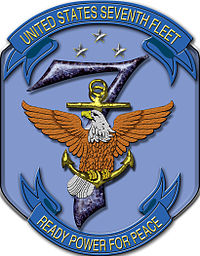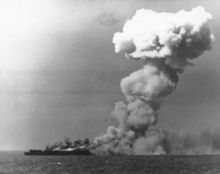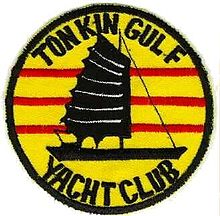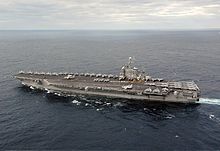- United States Seventh Fleet
-
"Seventh Fleet" redirects here. For other uses, see Seventh Fleet (disambiguation).
United States Seventh Fleet 
Seventh FleetActive 1943–Present Country United States Branch United States Navy Type Fleet Part of United States Pacific Fleet Garrison/HQ Yokosuka Nickname 'Tonkin Gulf Yacht Club' (Vietnam War) Commanders Current
commanderVice Admiral Scott H. Swift Notable
commandersAdmiral Thomas C. Kinkaid The Seventh Fleet is the United States Navy's permanent forward projection force based in Yokosuka, Japan, with units positioned near Japan and South Korea. It is a component fleet force under the United States Pacific Fleet. At present, it is the largest of the forward-deployed U.S. fleets, with 50 to 60 ships, 350 aircraft and 60,000 Navy and Marine Corps personnel. With the support of its Task Force Commanders, it has three major assignments:
- Joint Task Force command in a natural disaster or joint military operation,
- Operational command of all naval forces in the region, and
- Defense of the Korean Peninsula. In 1994, 7th Fleet was assigned the additional responsibility as Commander, Combined Naval Component Command for the defense of South Korea.
Contents
History
The Seventh Fleet was formed on 15 March 1943 in Brisbane, Australia, during World War II, under the command of Admiral Arthur S. "Chips" Carpender. It served in the South West Pacific Area (SWPA) under General Douglas MacArthur, and the Seventh Fleet commander also served as commander of Allied naval forces in the SWPA.
Most of the ships of the Royal Australian Navy were also part of the fleet from 1943 to 1945 as part of Task Force 74 (formerly the Anzac Squadron). The Seventh Fleet—under Admiral Thomas C. Kinkaid—formed a large part of the Allied forces at the Battle of Leyte Gulf, the largest naval battle in history. After the end of the war, the 7th Fleet moved its headquarters to Qingdao, China.
After the war, on 1 January 1947, the Fleet's name was changed to Naval Forces Western Pacific. On 19 August 1949, just prior to the outbreak of the Korean War, the force was designated as United States Seventh Task Fleet. On 11 February 1950, the force assumed the name United States Seventh Fleet, which it holds today.[1]
In late 1948, the 7th Fleet moved its principal base of operations to the Philippines, where the Navy, following the war, had developed new facilities at Subic Bay and an airfield at Sangley Point. Peacetime operations of the Seventh Fleet were under the control of Commander in Chief Pacific Fleet, Admiral Arthur E. Radford, but standing orders provided that, when operating in Japanese waters or in the event of an emergency, control would pass to Commander Naval Forces Far East, which was a component of Gen. Douglas MacArthur's occupation force.
Seventh Fleet units participated in every major operation of the Korean War. The first Navy jet aircraft used in combat was launched from a Task Force 77 (TF 77) aircraft carrier on 3 July 1950. The landings at Inchon, Korea were conducted by Seventh Fleet amphibious ships. The battleships Iowa, New Jersey, Missouri and Wisconsin all served as flagships for Commander, U.S. Seventh Fleet during the Korean War. During the Korean War, the Seventh Fleet consisted of Task Force 70, a maritime patrol force provided by Fleet Air Wing One and Fleet Air Wing Six, Task Force 72, the Formosa Patrol, Task Force 77, and Task Force 79, a service support squadron.
Over the next decade the Seventh Fleet responded to numerous crisis situations including contingency operations conducted in Laos in 1959 and Thailand in 1962. During September 1959, in the autumn of 1960, and again in January 1961, the Seventh Fleet deployed multiship carrier task forces into the South China Sea.[2] Although the Pathet Lao and North Vietnamese supporting forces withdrew in each crisis, in the spring of 1961 their offensive appeared on the verge of overwhelming the pro-American Royal Laotian Army. Once again the fleet sortied into Southeast Asian waters. By the end of April most of the Seventh fleet was deployed off the Indochinese Peninsula preparing to initiate operations into Laos. The force consisted of the Coral Sea and Midway carrier battle groups, antisubmarine support carrier Kearsarge, one helicopter carrier, three groups of amphibious ships, two submarines, and three Marine battalion landing teams. At the same time, shorebased air patrol squadrons and another three Marine battalion landing teams stood ready in Okinawa and the Philippines to support the afloat force. Although the administration of President John F. Kennedy already had decided against American intervention to rescue the Laotian government, Communist forces halted their advance and agreed to negotiations. The contending Laotian factions concluded a cease-fire on 8 May 1961, but it lasted only a year.
In June 1963 the Seventh Fleet held 'Flagpole '63,' a joint naval exercise with the Republic of Korea.[3]
During the Vietnam War, Seventh Fleet engaged in combat operations against enemy forces through attack carrier air strikes, naval gunfire support, amphibious operations, patrol and reconnaissance operations and mine warfare. After the 1973 cease-fire, the Fleet conducted mine countermeasure operations in the coastal waterways of North Vietnam. Two years later, ships and aircraft of the Fleet evacuated thousands of U.S. citizens and refugees from South Vietnam and Cambodia as those countries fell to opposing forces. Between 1950 and 1970, the U.S. Seventh Fleet was also known by the tongue-in-cheek nickname "Tonkin Gulf Yacht Club". Most of the fleet's operations were conducted from the Tonkin Gulf at the time. The badge was unofficial but it quickly became very popular.[4]
A carrier task force of the Seventh Fleet, TF 74, made a U.S. incursion into the Bay of Bengal at the height of the Bangladesh Liberation War in December 1971.[5] TF 74 comprised the nuclear-powered aircraft carrier Enterprise; the amphibious assault carrier Tripoli; the destroyers Decatur, McKean, and Orleck; the guided-missile escorts Waddell, King, and Parsons; the nuclear-powered attack submarine Gurnard; and supply ship Wichita. On 15 December, a day before the surrender of Pakistan, the task force entered the Bay of Bengal, at a distance of some 1,760 km (950 nmi; 1,090 mi) from Dhaka.
Since Vietnam, the Seventh Fleet has participated in a joint/combined exercise called Team Spirit, conducted with the Republic of Korea armed forces. With capability to respond to any contingency, Fleet operations are credited with maintaining security during the Asian Games of 1986 and the Seoul Olympics of 1988. During 1989, Seventh Fleet units participated in a variety of exercises called PACEX, the largest peacetime exercises since World War II.
In response to the 2 August 1990 Iraqi invasion of Kuwait, President George H. W. Bush ordered Commander, U.S. Seventh Fleet to assume additional responsibilities as Commander, U.S. Naval Forces Central Command (COMUSNAVCENT). The Fleet Commander departed Yokosuka, Japan immediately, heading for the Persian Gulf, and joined the remainder of his staff aboard the flagship Blue Ridge on 1 September 1990. During Operation Desert Shield and Operation Desert Storm, COMUSNAVCENT exercised command and control of the largest U.S. Navy armada since the Second World War. At the peak of combat operations, over 130 U.S. ships joined more than 50 allied ships to conduct maritime intercept operations, minesweeping and combat strike operations against enemy forces in Iraq and Kuwait.
COMUSNAVCENT included six aircraft carrier battle groups, two battleships (Missouri and Wisconsin), two hospital ships, 31 amphibious assault ships, four minesweeping vessels and numerous combatants in support of allied air and ground forces. After a decisive allied victory in the Gulf War, Commander U.S. Seventh Fleet relinquished control of COMUSNAVCENT to Commander, Middle East Force on 24 April 1991 and returned to Yokosuka, Japan to continue the duties of Commander, U.S. Seventh Fleet.
In 1996, two aircraft carrier battle groups were sent to the Taiwan Straits under Seventh Fleet control to demonstrate U.S. support for Taiwan during the Third Taiwan Strait Crisis. The Nimitz battle group made a high speed transit from the Persian Gulf, while the Independence battle group sortied from its Japanese homeports.
Operations
Of the 50-60 ships typically assigned to Seventh Fleet, 18 operate from U.S. facilities in Japan and Guam. These forward-deployed units represent the heart of Seventh Fleet. The 18 permanently forward-deployed ships of the U.S. 7th Fleet are the centerpieces of American forward presence in Asia. They are 17 steaming days closer to locations in Asia than their counterparts based in the continental U.S.. It would take three to five times the number of rotationally-based ships in the U.S. to equal the same presence and crisis response capability as these 18 forward deployed ships. On any given day, about 50% of Seventh Fleet forces are deployed at sea throughout the area of responsibility. The Seventh Fleet Command Ship is the USS Blue Ridge, forward deployed to Yokosuka, Japan. In 2004, Blue Ridge entered dry dock and command responsibility was transferred temporarily to USS Coronado. Blue Ridge returned to duty 27 September 2004.
Following the end of the Cold War, the two major military scenarios in which the Seventh Fleet would be used would be in case of conflict in Korea or a conflict between People's Republic of China and Taiwan (Republic of China) in the Taiwan Strait.
Fleet organization
For operational and administrative purposes the U.S. Seventh Fleet, as with other numbered fleets, is organized into several specialized task forces.
- Task Force 70 — TF 70 the Battle Force of 7th Fleet and is actually made up of two distinct components: Surface Combatant Force 7th Fleet, composed of cruisers and destroyers, and Carrier Strike Force 7th Fleet, made up of at least one aircraft carrier and its embarked air wing. The Battle Force is currently centered around Carrier Strike Group Five, the carrier USS George Washington and Carrier Air Wing 5 (CVW-5).
- Task Force 71 — TF 71 includes all Naval Special Warfare (NSW) units and Explosive Ordnance Disposal Mobile Units (EODMU) assigned to 7th Fleet. It is based in Guam. TF 71 operated the Search and Rescue/Salvage Operations for Korean Air Lines Flight 007 shot down by the Soviets off Sakhalin Island on Sept. 1, 1983. See Naval search for KAL 007. During the first half of 1965, the Seventh Fleet operationally controlled the Vietnam Patrol Force (Task Force 71), the American component of the Operation Market Time effort.[6] The Naval Advisory Group, headquartered in Saigon, served as the liaison between the fleet, COMUSMACV, and the South Vietnamese Navy. On 31 July 1965, formal control of the U.S. Operation Market Time force passed from the Seventh Fleet to the Naval Advisory Group, which in turn activated the Coastal Surveillance Force (Task Force 115). The fleet continued to provide logistic and administrative support. The command function was further refined on 1 April 1966 when Naval Forces, Vietnam, was established, relieving the Naval Advisory Group of responsibility for Market Time operations.
- Task Force 72 — TF 72 is the Patrol-Reconnaissance Force of the Seventh Fleet. It may be located at Naval Support Facility Kamiseya, Japan. It is mainly composed of anti-submarine warfare (ASW) aircraft and maritime airborne surveillance platforms such as P-3 Orion and EP-3 reconnaissance planes operating on land bases. Toward the end of the Korean War, Commander Task Force 72 transferred his flag to USS Pine Island on 7 March and detachments of VP-42 also left USS Salisbury Sound for that seaplane tender. That same day Task Force Seventy-Two was established as the Formosa Patrol Force under Rear Admiral Williamson in Pine Island.[7]
- Task Force 73/COMLOG WESTPAC — 7th Fleet's Logistics Force composed of supply ships and other fleet support vessels. Headquartered in Singapore.
- Task Force 74 — TF 74 was the designation used for the Enterprise's battle group in 1971. Today, it is the Fleet Submarine Force responsible for planning and coordinating submarine operations within 7th Fleet's area of operations.
- Task Force 75 — Designation of the Surface Combatant Force assigned to Seventh Fleet responsible for the cruisers and destroyers that are not assigned as escorts to aircraft carriers. Rear Admiral Rembrandt C. Robinson, U.S. Navy, at age 47, was Commander Cruiser Destroyer Flotilla Eleven and Commander, Cruiser Destroyer Group Vietnam, Seventh Fleet (CTF 75). Admiral Robinson was killed in a helicopter crash in the Gulf of Tonkin on May 8, 1972, during a late night landing approach to his flagship, the guided missile light cruiser USS Providence (CLG-6). The Seventh Fleet's flagship used to be frequently a cruiser. This cruiser, for example USS Oklahoma City (CG-5), would be assigned the designation of Task Group 70.1 when acting as fleet flagship and also act as part of Task Force 75 when carrying out Naval gunfire support.[8]
- Task Force 76 — Amphibious Assault task force mainly responsible for supporting Marine landing operations. It is composed of units capable of delivering ship-to-shore assault troops, such as Tarawa-class and Wasp-class amphibious assault ships, and landing craft. Rear Admiral Richard Landolt currently commands TF 76.[9]
- Task Force 77 — 7th Fleet Mine Warfare Force composed of mine countermeasure, mine hunter, and mine control ships as well as mine countermeasure helicopters (MH-53). This task force is only activated during specific combat operations and is filled by the Commander of Mine Warfare Command.
- Task Force 78 — As of 2010, Commander Naval Forces Korea, an administrative liaison unit between USFK, the ROK Navy, and Seventh Fleet, has been assigned the TF 78 designation. Naval Forces Korea is headquartered at Yongsan and has a base at Chinhae, Commander Fleet Activities Chinhae.
- Task Force 79 — The Marine expeditionary unit or Landing Force assigned to the fleet, consisting of at least a reinforced Marine battalion and its equipment. This unit is separate from the Marine Expeditionary Unit (MEU) normally embarked in USS Essex Amphibious Readiness Group (ARG). Marine units serving in 7th Fleet are normally drawn from III Marine Expeditionary Force (MEF) based in Okinawa, Japan.
Forward-deployed Seventh Fleet ships
U.S. Fleet Activities Yokosuka, Japan
Main article: U.S. Fleet Activities YokosukaU.S. Fleet Activities Sasebo, Japan
Main article: U.S. Fleet Activities SaseboApra Harbor, Guam
- Frank Cable
- City of Corpus Christi
- Houston
- Buffalo
- Ohio (Home-ported Bangor, Washington)
- Michigan (Home-ported Bangor, Washington)
Fleet Commanders
•Vice Adm. Arthur S. Carpender (15 March-26 November 1943) •Vice Adm. Thomas C. Kinkaid (26 November 1943 - 20 November 1945) •Vice Adm. Daniel E. Barbey (20 November 1945 - 2 October 1946) •Vice Adm. Charles M. Cooke, Jr. (2 October 1946 - 28 February 1948) •Vice Adm. Oscar C. Badger II (28 February 1948 - 28 August 1949) •Vice Adm. Russell S. Berkey (28 August 1949 - 5 April 1950) •Rear Adm. Walter. F. Boone (5 April - 20 May 1950) •Vice Adm. Arthur D. Struble (20 May 1950 - 28 March 1951) •Vice Adm. Harold. M. Martin (28 March 1951 - 3 March 1952) •Vice Adm. Robert P. Briscoe (3 March - 20 May 1952) •Vice Adm. Joseph. J. Clark (20 May 1952 - 1 December 1953) •Vice Adm. Alfred M. Pride (1 December 1953 - 9 December 1955) •Vice Adm. Stuart H. Ingersoll (19 December 1955 - 28 January 1957) •Vice Adm. Wallace M. Beakley (28 January 1957 - 30 September 1958) •Vice Adm. Frederick N. Kivette (30 September 1958 - 7 March 1960) •Vice Adm. Charles D. Griffin (7 March 1960 - 28 October 1961) •Vice Adm. William A. Schoech (28 October 1961 - 13 October 1962) •Vice Adm. Thomas H. Moorer (13 October 1962 - 15 June 1964) •Vice Adm. Roy L. Johnson (15 June 1964 - 1 March 1965) •Vice Adm. Paul P. Blackburn (1 March - 9 October 1965) •Rear Adm. Joseph W. Williams, Jr. (9 October - 13 December 1965) •Vice Adm. John J. Hyland (13 December 1965 - 6 November 1967) •Vice Adm. William F. Bringle (6 November 1967 - 10 March 1970) •Vice Adm. Maurice F. Weisner (10 March 1970 - 18 June 1971) •Vice Adm. William P. Mack (18 June 1971 - 23 May 1972) •Vice Adm. James L. Holloway III (23 May 1972 - 28 July 1973) •Vice Adm. George P. Steele (28 July 1973 - 14 June 1975) •Vice Adm. Thomas B. Hayward (14 June 1975 - 24 July 1976) •Vice Adm. Robert B. Baldwin (24 July 1976 - 31 May 1978) •Vice Adm. Sylvester Robert Foley, Jr. (31 May 1978 - 14 February 1980) •Vice Adm. Carlisle A.H. Trost (14 February 1980 - 15 September 1981) •Vice Adm. M. Staser Holcomb (15 September 1981 - 9 May 1983) •Vice Adm. James R. Hogg (9 May 1983 - 4 March 1985) •Vice Adm. Paul F. McCarthy, Jr. (4 March 1985 - 9 December 1986) •Vice Adm. Paul D. Miller (9 December 1986 - 21 October 1988) •Vice Adm. Henry H. Mauz, Jr. (21 October 1988 - 1 December 1990) •Vice Adm. Stanley R. Arthur (1 December 1990 - 3 July 1992) •Vice Adm. Timothy W. Wright (3 July 1992 - 28 July 1994) •Vice Adm. Archie R. Clemins (28 July 1994 - 13 September 1996) •Vice Adm. Robert J. Natter (13 September 1996 - 12 August 1998) •Vice Adm. Walter F. Doran (12 August 1998 - 12 July 2000) •Vice Adm. James W. Metzger (12 July 2000 - 18 July 2002) •Vice Adm. Robert F. Willard (18 July 2002 - 6 August 2004) •Vice Adm. Jonathan W. Greenert (6 August 2004 - 12 September 2006) •Vice Adm. William Douglas Crowder (12 September 2006 - 12 July 2008) •Vice Adm. John M. Bird (12 July 2008 - 10 September 2010) •Vice Adm. Scott R. Van Buskirk (10 September 2010 - 7 September 2011) •Vice Adm. Scott "Not So" Swift (7 September 2011 - Present[update])) References
- ^ [1]
- ^ By Sea, Air, and Land, Chapter 2, U.S. Navy
- ^ http://oldbluejacket.com/bexar.htm
- ^ Tonkin Gulf Yacht Club
- ^ [2]
- ^ By Sea, Air, and Land, Chapter 3, U.S. Navy
- ^ US Navy Historical Center, Korean War Naval Chronology, January–April 1953, accessed March 2008
- ^ http://www.okieboat.com/History/CG5%201975.pdf
- ^ United States Navy [3], accessed 7 May 2009
External links
Active Historic Categories:- Fleets of the United States Navy in World War II
- United States Navy units and formations in the Korean War
- Fleets of the United States Navy
Wikimedia Foundation. 2010.









